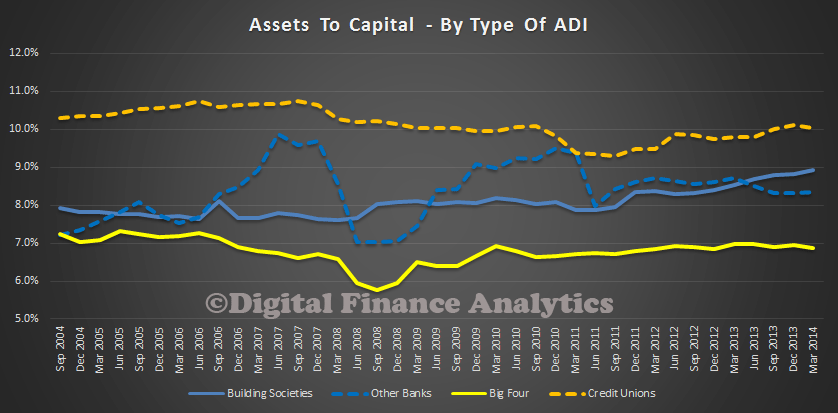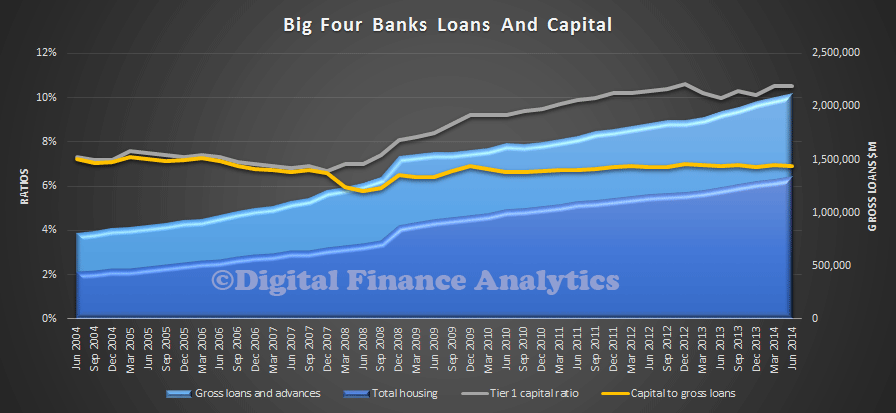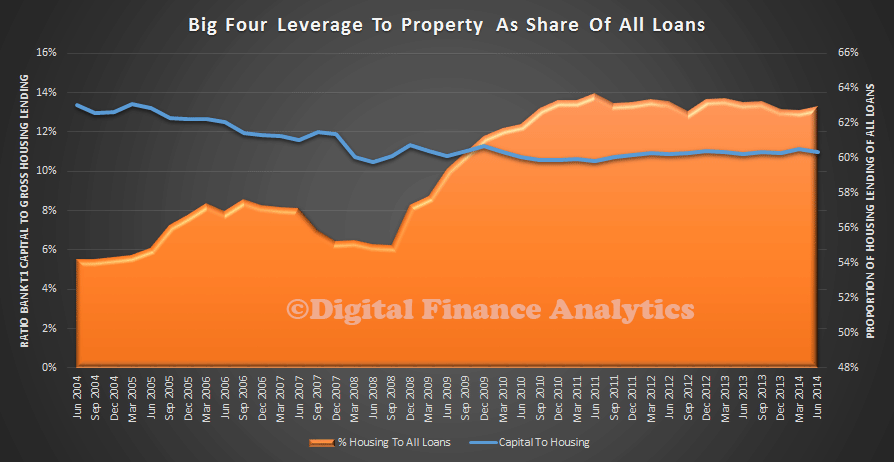A cornerstone of banking regulation and control is the application of capital ratios, which acts a brake on their ability to write more loans. The rules are set by the Bank of International Settlement, but they may be interpreted by local regulators, like APRA in Australia to take account of local conditions. BIS has no direct control. The calculations can be quite complex, because the rules offer the banks various options based on their sophistication, risk profile, and other factors.
Recently there has been a renewed focus on capital, triggered by a series of events.
- The FSI interim report made the point that smaller banks were at a competitive disadvantage in Australia because of differences in the capital required, and hinted that in the final report, they may recommend some changes.
- Some of the large players responded by suggesting that smaller banks should be allowed to move towards the more complex capital mechanisms, thus enabling them to complete. Others have suggested that the right move would be to lift the required ratios amongst the big four, who all use versions of the advanced capital scheme.
- In response APRA provided a further submission to the FSI inquiry, which went into significant detail around the question of capital.
- Meantime, Christopher Joye has published two posts showing that capital for the Australian large banks, in absolute terms had fallen, thanks to the move to the more advanced basis, since the GFC, despite all the talk (from banks and regulators) that capital had lifted. His latest was called “The inconvenient truth about our banks”.
- Two of the investment banks came out recently with estimates that revised capital arrangements might cost the industry between 12 and 24 billion.
- In a recent speech on macroprudential tools, the Head of The Monetary and Economic Department, BIS said “DTI ratios and, to a lesser extent perhaps, LTV ratios are comparatively more effective than increases in loan provisions or capital requirements.” This raises the question – is capital the best regulatory tool?
So, today we wanted to spend time today on this important capital issue.
First, the capital adequacy ratio (CAR) is simply the ratio between a bank’s core capital and it risk-weighted assets. It is a mechanism to protect depositors by limiting the banks’ ability to lend. Note that in banking language, assets are loans made by the bank, and liabilities are monies received by the bank. So deposits are a liability (because the bank will need to pay the deposit funds back at some point and interest meantime), whereas Loans are assets because they generate income for the bank).
Core capital is divided into tier 1 and tier 2 capital. Tier 1 capital (which includes things like paid up capital, disclosed reserves, after adjustments for intangibles and losses) is essentially capital which a bank may loose without having to cease trading; whilst Tier 2 capital (which undisclosed reserves, hybrid capital and subordinated debt etc.) offers less protection for depositors than Tier 1 capital but can absorb losses if the bank is wound up.
Assets of various types will hold different weightings. For example under the original Basel I capital guidelines loans to governments may be regarded as riskless (debatable in some cases?) and so are rated 0%, secured housing loans were assigned a 50% risk weighting, whereas other lending categories were weighted 100%.
The recent changes under Basel II and Basel III (yet to be fully implemented) extended the regulatory framework, and tweaked the capital weightings. In addition, in October 2012, the Basel Committee finalised its framework for dealing with domestic systemically important banks (D-SIBs). The D-SIB framework in Australia focuses only on the larger banks, APRA has determined that Australia and New Zealand Banking Group Limited; Commonwealth Bank of Australia; National Australia Bank Limited; and Westpac Banking Corporation are D-SIBs.
APRA’s recent second submission to the Murray Inquiry cover a range of capital-related issues. Here are some important extracts.
The average risk weight for residential mortgage exposures for ADIs using the standardised approach is currently in the order of 39 per cent; the comparable figure under the internal ratings based (IRB) approach is around 18 per cent. These figures are, however, not directly comparable.
The more risk-sensitive IRB approach generates, on the whole, a lower capital requirement for residential mortgage exposures than the standardised approach.
If smaller ADIs were to successfully obtain approval for use of the IRB approach for their credit portfolios, it is unlikely that the average risk weight for residential mortgage exposures for these ADIs would automatically settle at the same level as that of the major banks.
The Basel framework does not allow for the selective implementation of the IRB approach across individual credit portfolios. This stance is critical for protecting against cherry picking; it would also undermine the ability of ADIs to demonstrate they meet the use test.
Other options canvassed in the Interim Report involve changes to risk weights under the standardised approach, which would be contrary to the Basel framework.
The Interim Report suggests that ‘standardised risk weights do not provide incentives for the ADIs that use them to reduce the riskiness of their lending’. This is not the case in Australia: a simple tiered system of risk weights already exists. By way of example, consider a standard residential mortgage loan with no mortgage insurance. If the loan-to valuation ratio (LVR) is greater than 90 per cent, the loan receives a 75 per cent risk weight. Capital requirements decrease by one third (i.e. to a 50 per cent risk weight) if the LVR is reduced below 90 per cent and by a further third (i.e. to a 35 per cent risk weight) if the LVR is reduced below 80 per cent. There are also incentives for ADIs to obtain mortgage insurance; in general, risk weights for higher LVR loans are reduced by around one quarter if mortgage insurance is obtained.The opposite is true for non-standard loans, where risk weights relative to standard loans are increased by 25 to 50 per cent.
The effect of this tiering of risk weights is that under a minimum Common Equity Tier 1 (CET1) capital ratio of 7 per cent, ADIs with low-risk housing portfolios, i.e. all loans receiving a 35 per cent risk weight, could operate with leverage of around 40:1. It is not, therefore, correct to conclude that the standardised approach to credit risk is insensitive to risk.
If the Inquiry concludes that it is appropriate for APRA to consider a narrowing of the differential in risk weights for residential mortgage exposures between the standardised and IRB approaches to credit risk, the only proposed option in the Interim Report that would ensure continued compliance with the internationally agreed Basel framework would be to increase the average risk weight used by banks operating under the IRB approach.
Increasing IRB risk weights could be accomplished in various ways, including further increases to APRA’s minimum LGD requirement for residential mortgage exposures, or preferably through revised technical assumptions within the IRB framework. This issue should be considered in the context of the broader work being undertaken by the Basel Committee, as the impact of changes to risk weights needs to be carefully analysed. Greater prescription in IRB estimates may reduce incentives ADIs currently have to invest the resources and management attention required to model these estimates accurately. It may also make risk weights potentially less risk sensitive, and may change relative capital requirements across asset classes. Any considerations on this issue also need to be viewed within the context of the Inquiry’s deliberations regarding the positioning of Australia’s prudential framework relative to the global median.
So, with that in mind let’s look at the current state of play, using the APRA quarterly statistics, last published to June 2014. First, we calculated the ratio between the gross loans outstanding, and the Tier 1 capital held, over time. We see that the big four, relative to their loan portfolios, hold lower capital buffers than their competitors. Note this is a calculation based on the ratio of the value of gross loans made, and capital held under Tier 1, so excludes any capital weighting as the normal capital calculations do.

Next, because the big four are dominant – holding more than 85% of all lending, we will look at these players specifically. The chart below shows the growth in gross assets (loans) from Jun 2004, and the relative growth in housing lending, now 62% of all loans for the majors are housing related. Next we show the tier 1 capital ratio’s as calculated using IRB Basel, showing a rise to over 10% since 2004. On the other hand, a calculation of the ratio of capital to assets shows no change, so in absolute terms Joye is right, the big banks hold less capital now against their loans than they did.

Then we can look at the mix of property loans to total loans in more detail. It has risen by 10% since 2004, so the banks are more highly exposed to the property market than ever, (before we even start to consider whether they hold investment paper from buying securitised assets issued by the smaller players and non-banks.) If we look at the ratio of capital to housing loans, again we see a fall, thanks to the IRB system which Basel allows.

So, to conclude. First, it is true the big banks hold less capital against their loans than they did, thanks to the adoptions of IRB methods. This is in line with the global formulas and the banks here are fully capital compliant. Indeed on some measures Australia is more conservative in its application of the Basel formula than some other countries. One recent analysis indicated that if we applied the rules used in the UK to Australian Banks, total capital held could rise by 2-3%. That would lift the total capital levels (tier 1 and tier 2) to 14-15%, but this is still below the 17.5% targeted by the UK. Other suggest we need to be more conservative to be fully compliant. A 2012 IMF working paper said:
“The four major Australian banks have capital well about the regulatory requirements with high quality capital. While their headline capital ratios are below the global average for large banks in a sample of advanced and emerging market economies, Australia’s more conservative approach in implementing the Basel II framework implies that Australian banks’ headline capital ratios underestimate their capital strength. For example, a comparison with Canadian banks highlights the impact of Australia’s more conservative approach. The four major Australian banks are well-positioned to meet the higher capital requirements under Basel III, and with the improvements in their funding profiles since the global financial crisis they are making good progress toward meeting the Basel III liquidity standards. Stress tests calibrated on the Irish crisis experience show that the banks are largely able to withstand sizable shocks to their exposure to residential mortgages. However, combining residential mortgage shocks with corporate losses expected at the peak of the global financial crisis would bring down the banks ’ average total capital ratio below the regulatory minimum. Given high bank concentration and market uncertainty, therefore, the merits of higher capital requirements need to be considered for systemically important domestic banks, taking into account the currently evolving international standards”.
So, second, we in Australia have levels of capital lower than some other countries, even allowing for local variations.
Third, smaller players in Australia are operating in an environment, where they are holding more capital relative than the large players because of different capital rules, so they are at a competitive disadvantage. Lowering capital for these players is not the answer, the only option would be to lift the target for the larger players.
Next, the big four are heavily leveraged into property, to the point where we think there is a strong argument to insist the banks hold significantly more capital, to ensure financial stability, especially given their leverage to sky high property prices at the moment. Holding capital however costs, and holding more will reduce payouts to shareholders, and perhaps even lift rates to borrowers. We will see what The Murray Inquiry comes up with in due course.
One final thought, it appears to me that APRA has latitude under the D-SIB rules to raise the capital buffers further, this may be one neat method to address some of the capital concerns. In addition, perhaps macroprudential tools could be used to take some of the burden off capital controls, this seems to be advocated by BIS.

4 thoughts on “The Capital Conundrum”